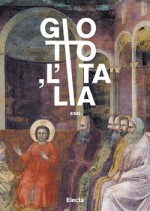This book is an example of a global collaboration (one of those that our school masters, Cesare Brandi and Giovanni Urbani would have liked) on a single work of art. The exhibition Giotto, l'Italia, held at the Palazzo Reale in Milan between September 2015 and January 2016, provided the opportunity and the resources which triggered a series of cognitive and preventive operations regarding the Stefaneschi Polyptych, Giotto's masterpiece which was once located in the heart of the Constantinian St. Peter's Basilica, where its colored lacquers and translucent varnishes must have shun like a big champlevé enamel, admired by believers and visitors from all over the world.
English edition.
It has been analyzed intus et in cute, scrutinized in all its parts, in every aspect of its physical saga (from its journey from the Basilica to the Vatican Pinacoteca) and in the philological as well as critical scrutiny, which has involved many generations of art historians, the altarpiece has not undergone, on this occasion, any further restoration. This was not the moment for major restoration interventions. It was essential to study the structure and the materials of the altarpiece, as well as the history of its execution. Lastly (it was the preliminary and non-negotiable condition for granting the loan to the Milan exhibition), it was necessary to secure, from a climatic point of view the whole altarpiece. Giotto’s Vatican masterpiece is now safely located in the heart of the Vatican Pinacoteca, protected by a complex clima frame system distributed across all the panels that make up the whole set. The Stefaneschi Polyptych, a masterpiece by Giotto, is the subject matter of this book. Heart of Constantinian Saint Peter’s Basilica in the past, it is nowadays conserved in the Vatican Pinacoteca. The pages of this monograph tell the events concerning its execution, exhibition and conservation, as well as its critical history. In addition for scholars, the book gives the results of recent scientific researches, carried out by Vatican laboratories, with the most innovative diagnostic techniques. X-radiography, ultra-violet shots and reflectography allow to understand the painting method used by the artist and his workshop. They show the employed materials, retracing how this masterpiece was born, how the wooden support was chosen and prepared, and also tell us about pigments, metallic foils and punches. Art historians, specialists, restorers: each one, with his own expertise, gives a contribution to shed light on the story of the Stefaneschi Polyptych, from his planning until the present return to the Vatican Pinacoteca, where it is at last protected from the best and most efficient climatic treatments.



